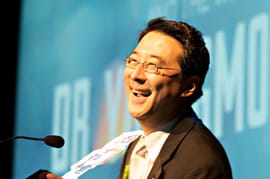What I'm Reading: Dr. Youngmoo Kim

Dr. Youngmoo Kim wears many hats at Drexel. He is director of the University’s Expressive and Creative Interaction Technologies (ExCITe) Center. He is also associate professor of electrical and computer engineering and assistant dean for media technologies at the College of Engineering. In all of his roles at Drexel, Kim finds a place for creativity.
Kim took the time to chat with DrexelNow about his current reading choice, The Rise of the Creative Class—Revisited (second edition) by Richard Florida.
Why did you choose this book?
This book started the nationwide discussion about the creative economy and the importance of creativity. So many different fields require creativity; the author groups them together and labels them the “creative class.” It’s anyone who employs creativity in their jobs. And really, that’s most of us.
Richard Florida actually wrote the first edition of this book 10 years ago. This second edition is a revision with a lot of updates, new statistics, and a couple of new chapters.
I chose this book initially because of my background in music and technology. At the center of both is creativity. I was interested in trying to understand its impact on industries and cities, what’s been written about it, and how people are defining it and researching it. And also, I really care about Philadelphia and about how Drexel can redefine the urban university of the future.
What is it about this book/topic that you find important or enjoyable?
Florida collected and analyzed a tremendous amount of data and determined that regions with a high density of members of the creative class were doing well in terms of economic development. Places like New York, San Francisco, Boston score well and are also generally regarded as “cool places to live.” Philadelphia does pretty well, but we think it could be doing a lot better.
His creativity metrics for regions follow what he refers to as the “3 Ts”: Technology, Talent, and Tolerance. The first two are well-accepted, but he was the first to demonstrate that a region’s diversity is strongly correlated with economic growth, because it indicates a region’s willingness to accept new ideas; creativity requires diversity.
He also provides evidence for a renewed trend in urban development and investment. A lot of big companies, especially tech companies like Google, Microsoft, Facebook, are moving back into cities from the suburbs, because that’s where their employees want to live. And they are investing in reusing and revitalizing urban spaces. Just look in Powelton and Mantua here in West Philadelphia. There are great opportunities here to convert an old abandoned building or warehouse into a co-working or studio space for tech startups, artists and social entrepreneurs.
Has the book lived up to your expectations?
Yes, it has. It can be kind of a dense read—it’s not the kind of thing you would pick up and read in a night. You have to read a bit and then process it and think about it for a little while and then move on.
Is there a passage or a quote you find particularly interesting?
In the book Florida writes, “The essential task before us is to unleash the creative energies, talent, and potential of everyone–to build a society that acknowledges and nurtures the creativity of each and every human being.”
I like this quote because humans are creative by nature—creativity is not a gift that’s bestowed upon the select few. I believe that creativity is part of being human and it’s in all of us.
Really, the future lies in creativity. The way that technology is evolving, we can automate so many things, roboticize things; what we can’t do it take away the creativity. Our jobs—whether it’s teaching, research, solving social problems, advertising, manufacturing—all of these positions require tremendous creativity.
In This Article
Drexel News is produced by
University Marketing and Communications.